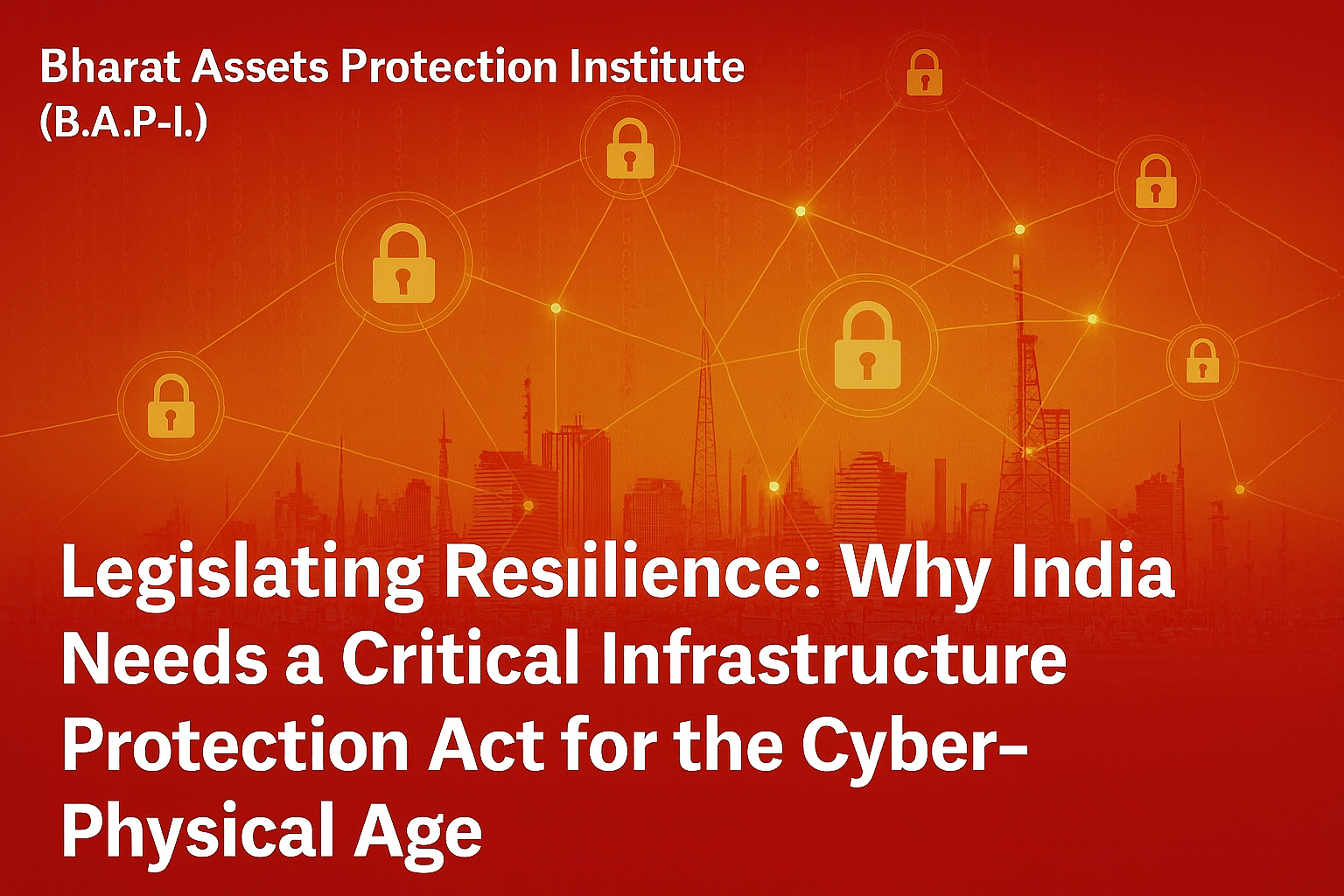
Article Keywords : Critical Infrastructure Protection, Critical Information Infrastructure, Cyber-Physical Convergence, Hybrid Threats, Resilience Metrics, Bharat National Resilience Index, Critical Infrastructure Protection Act, National Security, Cyber Governance, Strategic Resilience, Public–Private Collaboration, India

India’s
expanding digital and physical interdependence has transformed its Critical
Information Infrastructure (CII) into both an engine of growth and a domain of
vulnerability. The surge in hybrid threats—state-sponsored intrusions,
ransomware, and supply-chain disruptions—demands a unified statutory framework
that transcends fragmented governance. This article calls for the enactment of
a Critical Infrastructure Protection Act (CIPA) to institutionalise
cyber-physical resilience through structured vulnerability assessments,
coordinated response mechanisms, and measurable performance indices such as the
Bharat National Resilience Index (BNRI). By aligning technology, policy,
and accountability, CIPA can redefine national security as the sustained
continuity of India’s essential systems, ensuring that resilience becomes both
a legal mandate and a strategic instrument of comprehensive national power.
Introduction:
I. Introduction: The New Frontline of India’s National Resilience
In the twenty-first century, power no longer resides solely in
military arsenals or diplomatic alliances—it resides in networks, grids, and
data flows. India’s rise as a global power is inseparable from the robustness
of its critical infrastructure, yet these very arteries of national progress
have become the primary targets of hybrid conflict. The fusion of cyber and
physical domains has created an era where a malware-laden email or a
compromised sensor can paralyse a port, disrupt a hospital, or stall a national
grid. Traditional doctrines of security, once confined to territorial defence,
now falter before this invisible battlefield that straddles the physical and
the digital.
As the nation’s dependence on interconnected systems
deepens—from e-governance portals and financial networks to transport corridors
and energy pipelines—the cost of vulnerability grows exponentially. India’s
Critical Information Infrastructure (CII) forms the operational backbone of its
economy and governance, yet the protection mechanisms surrounding it remain
fragmented across ministries, regulatory bodies, and sectoral jurisdictions.
The result is an ecosystem where accountability diffuses faster than action,
and where reactive measures repeatedly substitute for strategic foresight.
The surge in state-sponsored cyber espionage, ransomware
strikes, and cascading supply-chain disruptions underscores a single truth: the
country’s infrastructure is under persistent siege, even during peacetime. Each
incident chips away not only at operational continuity but also at public trust
and investor confidence—core pillars of India’s economic trajectory. Moreover,
as Internet-of-Things (IoT) devices proliferate across industries, the attack
surface now extends into every factory floor, hospital ward, and transport
depot, demanding a defence architecture far more holistic than the one
envisaged a decade ago.
The time has therefore arrived for India to legislate resilience as a national mandate. A dedicated Critical Infrastructure Protection Act (CIPA) must emerge as the legal and operational cornerstone for securing the nation’s most essential assets against hybrid, transnational, and techno-economic threats. Such legislation would integrate cyber and physical protection frameworks, codify accountability across stakeholders, and institutionalise predictive readiness through continuous assessment and resilience metrics.
“CIPA
represents not merely a law but a doctrine—one that redefines security as the
uninterrupted continuity of India’s digital, industrial, and civic lifelines.”
By embedding this principle within a comprehensive national
framework, India can transition from reactive cybersecurity management to
proactive resilience governance—where protection becomes performance, and
preparedness becomes policy. The following sections of this editorial trace
that imperative: the technological pillars, the evolving threat matrix, the
policy architecture, and the strategic outcomes that together define India’s
path toward a truly secure and sovereign future.
II. Core Pillars of
Cyber-Physical Integration: Building a Resilient India
1. Rethinking Vulnerability Assessment
Understanding vulnerabilities today demands more than scanning firewalls or encrypting data; it calls for decoding how digital sabotage can paralyse physical assets. The cascading blackout in the Indian power grid during 2020 revealed how invisible cyber intrusions can cripple tangible utilities—an alarm that India’s infrastructure is living on borrowed time. By contrast, vulnerability assessments must now evolve into context-aware, cross-sector audits that trace the entire chain from control systems to supply links.
“India
urgently requires a unified vulnerability mapping protocol under the proposed
Critical Infrastructure Protection Act (CIPA), ensuring every Tier-I asset
undergoes cyber-physical simulation testing at least twice a year.”
2. Risk Mitigation as Continuous Architecture
Risk mitigation in the hybrid age is less about reaction and more about design. When ransomware crippled hospital networks during the COVID-19 crisis, the consequence was not just data loss—it endangered lives, delayed operations, and eroded trust in public systems. Hence, mitigation strategies must be architected into daily operations, blending predictive analytics with behavioural threat detection. However, this transformation cannot occur in silos; collaboration between security agencies, regulators, and private operators remains the missing link.
“CIPA
should institutionalise joint cyber-physical risk cells across critical
ministries, embedding AI-driven early-warning platforms linked directly to
NCIIPC and CERT-In.”
3. Rapid Response as National Reflex
In practice, resilience is tested not by prevention but by response speed. The 2021 cyber intrusion targeting India’s regulatory network exposed both technological fragility and bureaucratic inertia. Yet, it also demonstrated that coordinated containment can avert national-scale disruption when readiness meets discipline. Rapid response must therefore become a reflex—supported by real-time threat intelligence, empowered decision nodes, and secure communication channels that transcend institutional walls.
“India
should operationalise a National Cyber-Physical Incident Command (NC-PIC)
within the CIPA framework, enabling live coordination among defence, CERT-In,
and sectoral PSUs during hybrid crises.”
III. The Evolving Threat
Landscape in India: From Disruption to Hybrid Subversion
1. State-Sponsored Intrusions and Strategic Espionage
The contest for digital dominance has turned India’s critical infrastructure into a strategic battleground. State-sponsored actors no longer merely seek disruption; they pursue persistence—lurking within grids, satellites, and telecom backbones for months to exfiltrate data or sabotage at will. Energy dispatch centres and financial networks, in particular, have become preferred targets of geopolitical leverage. However, India’s current incident-response chains remain fragmented across ministries, diluting accountability and delaying containment.
“A
CIPA-mandated National Cyber Defence Fusion Grid should synchronise NCIIPC,
CERT-In, NTRO, and DRDO under one secure operations architecture to counter
state-sponsored hybrid incursions in real time.”
2. Ransomware: From Digital Extortion to Economic Disruption
Ransomware has evolved from petty extortion to a national-scale economic weapon. Banks, hospitals, and payment gateways have faced coordinated encryption attacks aimed at collapsing trust rather than collecting ransom. By contrast, the absence of a unified ransomware incident protocol often leaves affected entities negotiating in digital darkness, amplifying both losses and public panic. India’s response therefore must transcend patchwork advisories and move toward codified, sector-specific resilience playbooks.
“CIPA
should institutionalise a Central Ransomware Response & Recovery Registry,
compelling all CI operators to report breaches within six hours and enabling
blockchain-verified forensic recovery pathways.”
3. Supply Chain Cascades: The Invisible Frontline
In practice, cyber-physical resilience is only as strong as its weakest supplier. A single compromised logistics or IT vendor can paralyse multiple sectors—a truth India learned when a major freight operator’s breach rippled through food, pharma, and retail networks. The challenge is that oversight ends where outsourcing begins. Hence, third-party risk has emerged as the new national vulnerability frontier.
“CIPA
must mandate ‘trusted-vendor certification’ and enforce cyber-resilience
clauses in every government and PSU procurement contract exceeding ₹10 crore.”
4. IoT Vulnerabilities: The Trojan Network
The proliferation of IoT devices has woven a lattice of efficiency—and exposure—across India’s critical infrastructure. From smart grids to medical sensors, millions of connected nodes now blur the boundary between convenience and catastrophe. Yet, IoT governance remains scattered across ministries without a unified testing regime or liability framework. Notably, every unpatched sensor is a silent backdoor.
“A
National IoT Assurance Framework under CIPA should require pre-deployment
security validation and lifecycle patch-management audits for all devices
integrated into Tier-I critical systems.”
5. Insider Threats: The Silent Catalyst of Collapse
Hybrid security breaches often originate not from foreign servers but from within. Disgruntled employees, compromised contractors, or careless insiders can trigger systemic breakdowns more devastating than external hacks. In an interconnected ecosystem, one internal breach can cascade across banks, grids, or data centres within minutes. However, most Indian organisations still treat insider threats as HR problems rather than national-security liabilities.
“CIPA
should enforce classified-level vetting for personnel in critical facilities
and empower sectoral security officers to conduct random digital forensics on
internal endpoints.”
IV. Emerging Technologies
and Regulatory Pressures: The Crossroads of Innovation and Governance
1. AI and Machine Learning: The Double-Edged Intelligence
Artificial Intelligence has transformed from a defensive toolkit to a weapon of ambiguity—empowering both guardians and adversaries of India’s digital fortress. Machine Learning engines now anticipate threat patterns faster than humans can blink, yet the same logic is mirrored by cyber-criminals automating deception and intrusion. The paradox lies in governance: how to exploit AI’s velocity without surrendering control. In practice, India’s Critical Information Infrastructure (CII) demands predictive, autonomous threat-response systems embedded within national command networks.
“CIPA
must institutionalise an AI-Assured Security Sandbox under the NCIIPC to test
and certify AI-driven defence models for all Tier-I and Tier-II critical
assets.”
2. Regulatory Pressures and the Global Compliance Wave
Regulation has shifted from suggestion to survival. Across continents, governments are imposing punitive accountability for security lapses, and India cannot afford to lag behind. The Information Technology Act and the National Cyber Security Policy provide a skeletal base, but they lack a binding architecture that enforces measurable compliance. Notably, most public-sector undertakings and state utilities still operate without real-time audit trails or incident-reporting compulsion. Hence, legislation must evolve beyond paperwork to performance-based governance.
“CIPA
should empower a National Infrastructure Security Regulator (NISR) with
statutory oversight, enabling graded penalties and public disclosure for
non-compliant critical-sector entities.”
V. The Case for a
Critical Infrastructure Protection Act (CIPA): Legislating Resilience for the
Hybrid Age
3. Addressing the Full Spectrum of Threats
Hybrid threats blur the line between cyber intrusion and physical sabotage. A CIPA framework must therefore unify intelligence, law enforcement, and operational oversight to anticipate such convergence. It is no longer sufficient to react after a breach; pre-emptive diagnostics, sectoral risk heat-maps, and red-teaming drills must become law.
“CIPA
should legally mandate bi-annual hybrid-threat simulation exercises across all
national grid and telecom operators under joint supervision of the Home and
Power ministries.”
4. Sectoral Inclusivity and Prioritisation
Criticality is contextual—what fuels the economy one day can cripple governance the next. The Act must move beyond the traditional NCIIPC list and include logistics, healthcare, maritime, and smart-city ecosystems. By categorising assets by strategic dependency rather than ownership, India can allocate protection proportionate to systemic risk.
“CIPA
should establish a dynamic National Criticality Register (NCR) classifying
assets into Tier-I, II, and III, with annual resilience scoring linked to
funding eligibility.”
5. Cyber-Physical Integration as National Doctrine
By contrast to segmented policies, hybrid resilience demands doctrinal fusion—where firewalls and fences are governed by one strategy. Each cyber-alert should trigger a physical countermeasure, and every physical breach should activate digital containment. Such symmetry defines true national readiness.
“CIPA
must codify dual-domain incident protocols requiring all operators to maintain
integrated Security Operations Centres (iSOCs) combining digital forensics and
field response.”
6. Threat Assessment and Resilience Benchmarks
Resilience must be quantifiable. Without mandatory audits, red-teaming, and recovery benchmarks, “security” remains rhetorical. India’s approach should institutionalise resilience metrics—mean-time-to-recovery (MTTR), redundancy scores, and continuity indices—evaluated through independent agencies.
“CIPA
should enshrine the Bharat National Resilience Index (BNRI) as the official
measurement tool for evaluating CI performance and funding allocations.”
7. Shared Accountability and Stakeholder Mandates
Safeguarding national assets cannot remain the government’s solitary burden. Private operators control most of India’s digital arteries; their obligations must therefore be statutory, not voluntary. The Act must clearly distribute responsibility among ministries, PSUs, private licensees, and state regulators to avoid bureaucratic diffusion.
“CIPA
should introduce a ‘Shared Accountability Clause’ requiring every CI operator
to appoint a Chief Resilience Officer (CRO) with joint reporting to the
sectoral regulator and the National Security Council Secretariat.”
8. Integrating National Power and Strategic Depth
Critical infrastructure is the engine of national power—its disruption equates to strategic paralysis. Hence, CIPA cannot be a stand-alone legal tool; it must feed into India’s defence posture, trade policy, and innovation roadmap. Energy autonomy, digital sovereignty, and manufacturing resilience are interlinked pillars of security.
“CIPA
should align with the Make in India and Atmanirbhar Bharat missions by
mandating indigenous cybersecurity hardware and encryption stacks in all
strategic sectors by 2030.”
9. Confronting Hybrid Subversion through Legal Teeth
Finally, deterrence must be as visible as resilience. The law should articulate penalties for sabotage, cyber-terrorism, and insider collusion under a unified penal schedule with extraterritorial reach. India’s adversaries exploit the absence of explicit hybrid-offence statutes; this vacuum must close.
“CIPA
should designate hybrid cyber-physical attacks on critical infrastructure as
acts of ‘National Economic Terrorism,’ invoking counter-terror finance and
asset-freezing provisions under the Unlawful Activities (Prevention) Act
(UAPA).”
VI. The Era of
Cyber-Physical Convergence: The Imperative of CIPA
The walls separating the digital and physical realms have all
but vanished. Every control room, satellite uplink, and logistics terminal now
exists within a shared vulnerability field where a single cyber compromise can
trigger kinetic paralysis. India’s Critical Information Infrastructure (CII)
has thus become both a strategic enabler and a potential pressure point of
national power. However, while the country has advanced in digital
connectivity, its protective doctrines remain anchored in outdated binaries—cyber
handled by IT cells, and physical by law enforcement. This division is
unsustainable in an age when adversaries exploit the seams between the two.
In practice, convergence demands an architectural rethink—one where data encryption, access control, and situational awareness form a continuous loop between command networks and physical perimeters. The coming decade will test whether India can institutionalise this hybrid discipline through legislation rather than ad-hoc coordination.
“CIPA
must establish a Unified Cyber-Physical Resilience Command integrating CERT-In,
NCIIPC, NDMA, and the Defence Cyber Agency under a single 24×7 fusion node to
monitor, predict, and neutralise cross-domain threats in real time.”
By contrast, resilience is not achieved merely by technology adoption but by codifying readiness, accountability, and deterrence. As Internet of Things (IoT) devices multiply within energy grids, transportation hubs, and public health systems, the attack surface expands exponentially. Each connected sensor becomes a potential vector of infiltration. Hence, proactive vulnerability analytics and AI-assisted defence architectures must become standard practice rather than reactive improvisation.
“CIPA
should legally mandate Digital-Twin-Based Stress Testing for all Tier-I
critical assets every fiscal year, verifying operational integrity under
simulated cyber-physical breach scenarios.”
Ultimately, the convergence era compels India to treat
cyber-physical resilience as a sovereign function of statecraft. Securing CII
is no longer about defending networks—it is about preserving economic
continuity, strategic deterrence, and civil order. In this evolving theatre of
invisible warfare, the Critical Infrastructure Protection Act will serve as
India’s legislative shield, aligning technology, governance, and deterrence
into one integrated command of national survival.
Critical Outcome Statement: Towards a National Resilience
Compact under CIPA
India’s ascent as a strategic and technological power cannot
rest on unsecured foundations. The nation’s digital arteries, energy grids, and
logistics corridors have become the new frontlines of national security — where
hybrid adversaries strike silently, and recovery often costs more than
prevention. By contrast, India’s current frameworks remain fragmented across
ministries, producing overlapping responsibilities and diluted accountability.
The Critical Infrastructure Protection Act (CIPA) therefore emerges not
as an optional reform, but as the constitutional expression of a Resilient
Republic — a legislative framework that treats infrastructure security as
the backbone of sovereignty itself.
The outcome of this vision must be tangible: the creation of a unified, metrics-driven national protection architecture that blends governance, law enforcement, research, and industry under one operational ethos. CIPA should not only legislate protection but also measure it — through resilience indices, periodic stress-tests, and transparency mechanisms that bind both public and private operators. The Act must institutionalise foresight rather than reaction, deterrence rather than rhetoric.
“CIPA
should be ratified as a statutory pillar of India’s Comprehensive National
Power — embedding the Bharat National Resilience Index (BNRI) as its
performance compass, legally obligating every Tier-I sector to demonstrate
cyber-physical readiness, redundancy assurance, and continuity planning as
annual compliance benchmarks.”
In essence, the protection of Critical Information
Infrastructure (CII) is no longer a technical agenda but a civilisational one.
As India steps deeper into an era defined by data, automation, and
interdependence, resilience becomes the truest currency of national power. The
enactment of CIPA, therefore, represents not just a security measure but the
formal birth of India’s integrated resilience doctrine — one capable of
withstanding, adapting to, and triumphing over the hybrid complexities of the
21st century.
[This work has been
funded by the Indian Council of Social Science Research (ICSSR), Ministry of
Education, New Delhi, under the ―|| ICSSR Post-Doctoral Programme || 2019-20]
Dr. Dash is a defense
and security expert with a strong focus on India’s evolving security
architecture. He writes extensively on politics, diplomacy, and
international affairs, while specialising in internal security and
critical infrastructure protection. His work bridges policy, strategy, and practice, offering insights that connect ground
realities with national resilience imperatives.



